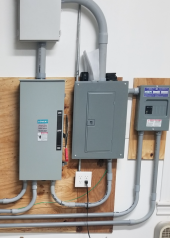energyhunter
New Member
- Joined
- Feb 20, 2022
- Messages
- 83
I'd like to see that pic Zwy, thx. NEWS FLASH! ......Today I called Tec at S.S. I told the tec that the EG4 video about the NG bond left me more confused because not once did the fellow mention grid ASSIST, only "connection to grid" which begged the question.I should snap a photo of my panel setup, the 2 electrical panels and transfer switch are about 15 feet away from the inverters. I did add a 60A double pole breaker in a cheap Homeline 70A breaker panel to the inverter output. I'll post up a photo over the weekend.
Also I told him about some folks on the forum who were concerned about power on the neutral, general safety and the convenience of disconnection if necessary. I said that I had been directed to remove the NG Bonding screws in both of my inverters. I expressed "voiding the warranty" concern about removing the cover.
In a nutshell his response was, leave the screws there because the latest firmware at eg4electronics.com/downloads (House/Cabin) had addressed that issue as of 2 weeks ago and it was no longer necessary to remove the screws because the software disables the relay that connects and creates the bond. When I asked about current on the neutral he indicated there should be none but I could use my tester. Takeaway - New firmware download will solve NG problem; don't remove screws.
When I asked if the 3P double throw switch was necessary he said no. I was left thinking to myself maybe I just need a safety switch. He suggested I talk to the design team. He admitted there are certain things he can't say due to liability issues.
At any rate, I'm not concluding that you all with the 3P switches are wrong, but I sure would like feedback from a few of you on this new information. ?







